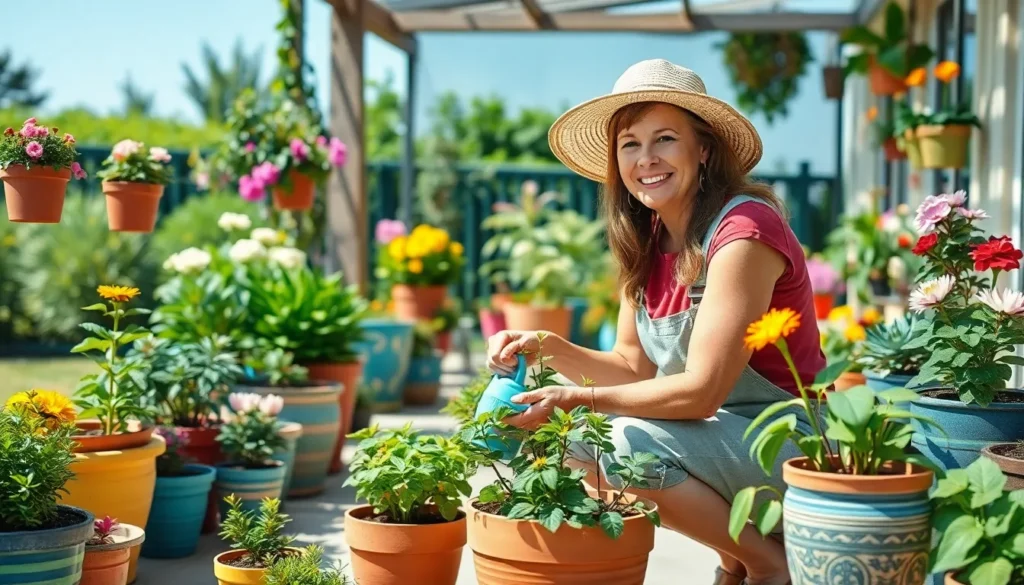We’ve all admired those stunning outdoor spaces that perfectly blend natural beauty with thoughtful design. But what if we told you that achieving that magazine-worthy industry doesn’t require extensive gardening expertise or permanent plantings? Potted plants offer the ultimate solution for creating ever-changing outdoor landscapes that can evolve with your style and seasons.
The beauty of container gardening lies in its incredible flexibility. We can transform patios, decks, balconies, and even small yards into lush retreats using strategic plant placement and creative pot arrangements. Whether you’re dealing with challenging soil conditions, rental restrictions, or simply want the freedom to redesign your space regularly, potted plants deliver professional-looking results without the commitment.
From vibrant flower displays to architectural statement pieces, container landscapes allow us to experiment with color, texture, and height in ways traditional gardens simply can’t match. Let’s explore how to harness this versatile approach to create outdoor spaces that truly reflect your personal style.
Choose the Right Containers for Your Outdoor Potted Plant Landscape
Selecting the perfect containers forms the foundation of any successful outdoor potted plant industry. We’ll guide you through the essential factors that determine which pots will keep your plants thriving while improving your outdoor space’s aesthetic appeal.
Consider Drainage Requirements
Proper drainage prevents root rot and creates healthy growing conditions for your outdoor potted plants. Look for containers with multiple drainage holes at least 1/4 inch in diameter to ensure excess water flows freely from the soil.
Check the container’s base design before purchasing since some decorative pots lack adequate drainage holes. We recommend drilling additional holes if your chosen container doesn’t provide sufficient water escape routes.
Position containers on pot feet or saucers to elevate them above ground surfaces and improve airflow around drainage areas. This elevation prevents water from pooling underneath your pots and reduces the risk of pest attraction.
Test drainage effectiveness by filling new containers with water and timing how quickly it empties. Quality outdoor containers should drain completely within 10 to 15 minutes of filling.
Select Weather-Resistant Materials
Weather-resistant materials ensure your containers withstand seasonal temperature changes and precipitation patterns. Choose materials like fiberglass, resin, or glazed ceramic that resist cracking during freeze-thaw cycles common in many climates.
Avoid terracotta and unglazed clay pots in areas experiencing freezing temperatures since moisture absorption leads to cracking and breaking. These materials work well in consistently warm climates but require protection during cold seasons.
Consider lightweight options such as high-density polyethylene or composite materials for containers you’ll move seasonally. These materials offer durability without the weight burden of traditional ceramic or concrete options.
Evaluate UV resistance ratings when selecting plastic or resin containers to prevent fading and brittleness from sun exposure. Quality outdoor containers feature UV stabilizers that maintain color and structural integrity for multiple growing seasons.
Match Container Size to Plant Needs
Container size directly impacts root development and overall plant health in your outdoor industry design. Select pots that provide adequate space for root systems to expand while maintaining proper soil moisture levels.
| Plant Type | Minimum Container Size | Depth Requirement |
|---|---|---|
| Small herbs | 6-8 inches diameter | 6-8 inches deep |
| Medium perennials | 12-16 inches diameter | 10-12 inches deep |
| Small shrubs | 18-24 inches diameter | 16-20 inches deep |
| Large trees | 24+ inches diameter | 20+ inches deep |
Plan for future growth by choosing containers 2 to 4 inches larger than your plant’s current root ball diameter. This extra space allows roots to establish without requiring frequent repotting.
Consider the plant’s mature size when selecting permanent outdoor containers since some species double or triple in size over growing seasons. We suggest researching each plant’s expected growth rate before making final container selections.
Balance container proportions with plant height to create visually appealing arrangements that won’t become top-heavy or unstable in windy conditions. A general rule suggests container height should equal one-third of the total plant height for optimal stability and aesthetics.
Select Plants That Thrive in Outdoor Containers
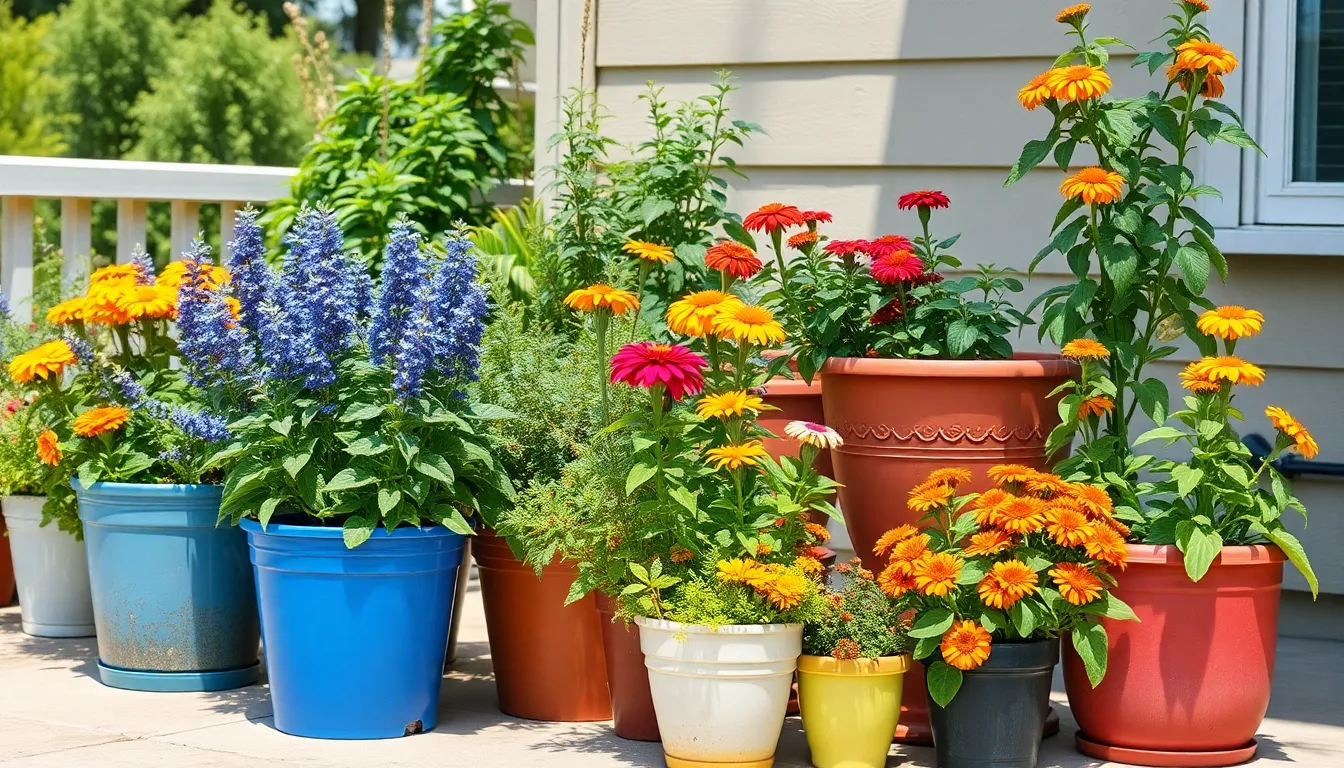
Now that we’ve chosen our containers, we need to focus on selecting plants that’ll flourish in these outdoor environments. Container gardening requires exact plant varieties that can handle confined root space and varying outdoor conditions.
Pick Climate-Appropriate Species
Garden sage (Salvia officinalis) stands out as an excellent choice for sunny locations since it prefers full sun and drier soil conditions. We’ll find that marigolds and black-eyed Susan vines flourish in warm, sunny patios with full sun exposure. Tropical vines like red mandevilla thrive in warm climates when they receive some afternoon shade protection.
Winter jasmine adapts well to various conditions since it tolerates drier soils and isn’t particularly picky about soil types. For shady outdoor areas, we can rely on hosta and heuchera as they perform exceptionally well in pots. Matching our plant selections to local heat, light, and moisture conditions ensures long-term success in our container landscapes.
Choose Plants with Similar Water Requirements
Grouping plants with compatible watering needs prevents the common problems of over-watering or under-watering our containers. Garden sage thrives with infrequent watering once established since it prefers drier soil conditions. Winter jasmine also tolerates dry conditions but needs occasional watering when the soil becomes dry.
Plants like cuphea hyssopifolia require regular feeding and water but benefit from afternoon shade in hot climates. We’ll create more successful container arrangements by clustering drought-tolerant species together and keeping water-loving plants in separate groupings. This approach allows us to provide targeted care without compromising any plant’s health.
Consider Seasonal Interest and Bloom Times
Black-eyed Susan vines provide continuous bright yellow or orange flowers throughout the summer months. Winter jasmine creates spectacular displays when it blooms in winter or early spring seasons. We can achieve year-round visual appeal by selecting plants with staggered flowering periods.
Mixing perennials with annuals gives us different flowering seasons and varying foliage textures throughout the year. Trailing verbena, calibrochoa, sun coleus, and agastache offer excellent adaptability and vibrant color options for our container displays. Planning for continuous seasonal interest keeps our outdoor potted landscapes attractive and captivating as seasons change.
Design Your Potted Plant Layout for Maximum Visual Impact
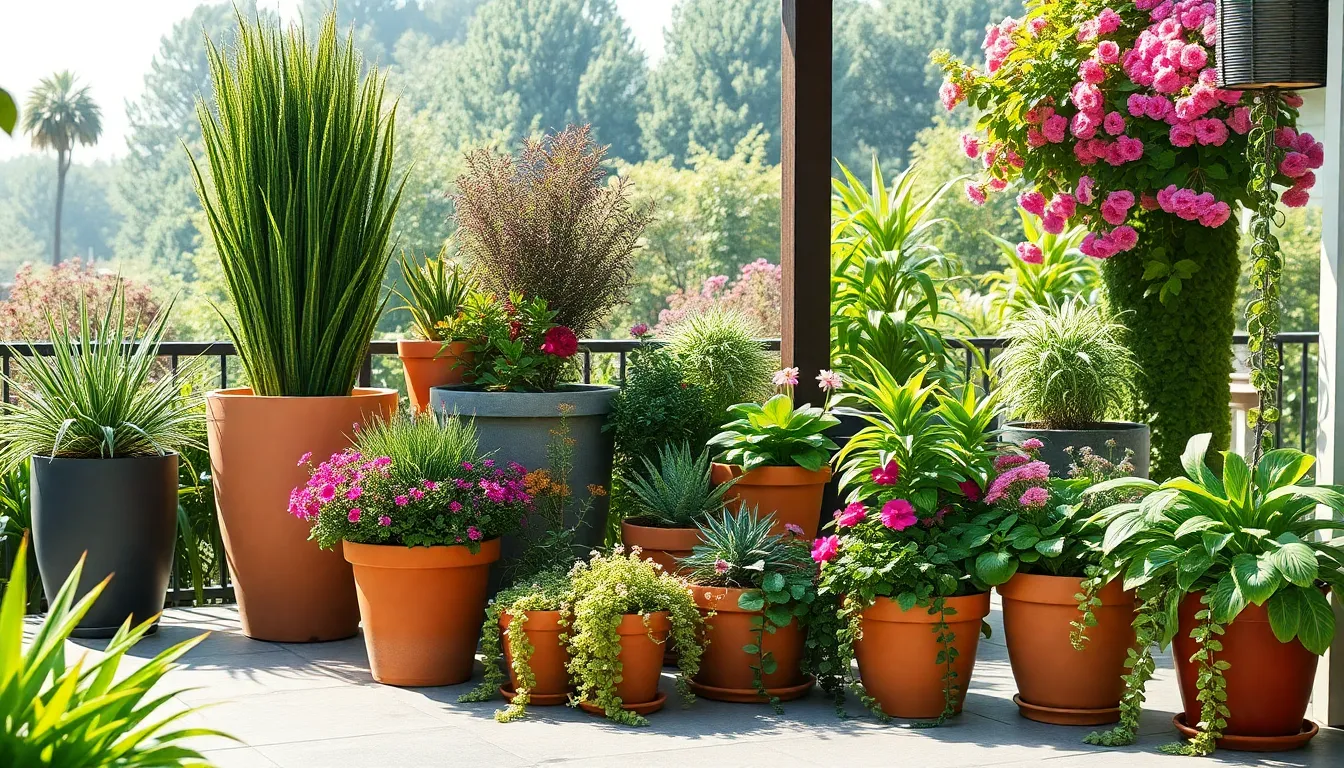
Strategic container arrangement transforms ordinary spaces into captivating outdoor displays. We’ll create rhythm and repetition by grouping containers with varied plant forms and colors in balanced arrangements that guide the eye through our industry.
Create Height Variations with Different Container Sizes
Layered dimensions emerge when we vary container heights and sizes throughout our design. We select plants that grow to 1.5 to 2 times the container’s height or diameter for proper proportion and visual balance.
Taller containers with upright plants serve as visual anchors in our arrangement. Medium height containers fill the middle ground while shorter containers soften edges and add depth layers. Trailing plants in elevated positions create cascading effects that prevent flat, monotonous designs.
Staggered placement of different sized containers mimics natural industry undulation. We position our tallest containers toward the back or center of groupings, then graduate down to smaller sizes. This technique promotes depth perception and creates more ever-changing outdoor vignettes.
Use Color Theory to Arrange Plant Combinations
Color harmonies boost the aesthetic impact of our container landscapes significantly. Contrasting colors catch the eye and create vibrant focal points, while analogous colors produce calming, cohesive effects throughout our design.
Foliage colors contribute as much visual interest as flower colors in our arrangements. We mix complementary tones like purple and yellow or use monochromatic schemes with varying shades of the same hue. Texture and leaf shape enhance these color effects by adding contrast or creating smooth blending between plants.
Seasonal color transitions keep our displays interesting year round. We incorporate plants with different bloom times and foliage changes to maintain visual appeal. Bold color combinations work well for contemporary spaces, while subtle palettes suit traditional outdoor settings.
Establish Focal Points Throughout Your Industry
Strategic focal points guide visitors and create memorable visual experiences in our container gardens. We use the thriller, filler, spiller principle with tall eye catching plants as centerpieces surrounded by volume building fillers and cascading spillers.
Placement of focal containers along pathways or near gathering areas anchors our design flow effectively. We position these statement pieces at natural stopping points where people pause to appreciate the industry. Multiple focal points create visual rhythm without overwhelming the overall composition.
Repetition of similar focal elements ties our entire industry together cohesively. We echo colors, textures, or plant forms in different areas to create unity while maintaining individual character in each container grouping. This approach ensures our potted plant industry feels intentional rather than randomly assembled.
Position Your Potted Plants for Optimal Growing Conditions
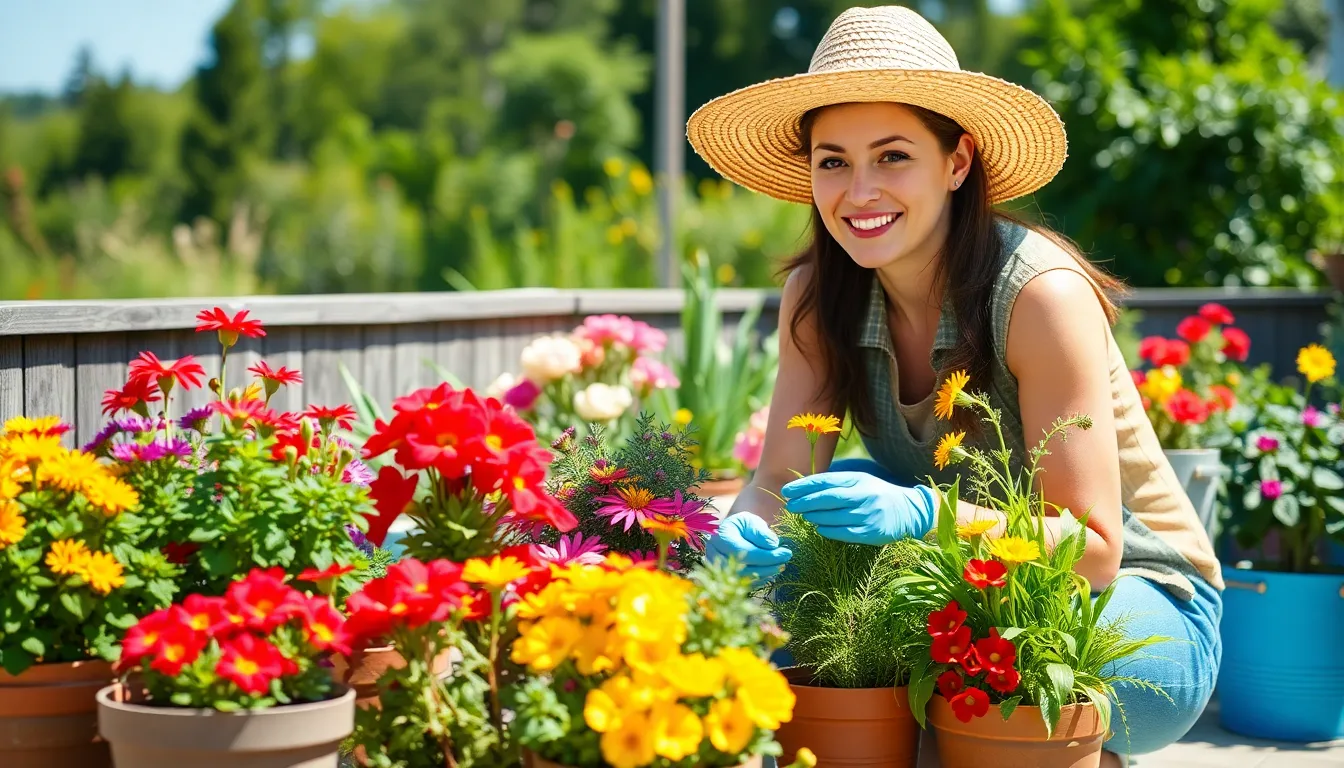
Strategic placement of your container plants determines their health and your industry’s overall success. We’ll guide you through three essential positioning factors that make the difference between thriving plants and struggling specimens.
Assess Sunlight Requirements for Each Plant
Understanding each plant’s light needs forms the foundation of successful container placement. We recommend identifying whether your plants require full sun, partial shade, or full shade before selecting their permanent locations.
Full sun plants need 6-8 hours of direct sunlight daily and should be positioned in bright, open areas away from shadows. Examples include tomatoes, peppers, and most flowering annuals that thrive in unobstructed light.
Partial shade plants prefer 3-6 hours of morning sun with afternoon protection and work best under pergolas or near structures that create filtered light. Hostas, begonias, and ferns flourish in these transitional zones.
Full shade plants require fewer than 3 hours of direct sunlight and should be placed under trees, awnings, or north-facing walls. Caladiums, impatiens, and certain ferns excel in these protected environments.
We suggest observing your outdoor space throughout the day to map sun patterns before committing to exact plant locations. This prevents costly mistakes and ensures optimal growing conditions from day one.
Consider Wind Exposure and Protection Needs
Wind exposure significantly impacts potted plants since containers provide less root stability than ground plantings. We’ve found that strong winds can damage delicate foliage, topple containers, and accelerate soil moisture loss.
Identify wind corridors in your outdoor space by observing how air moves between buildings, around corners, and through open areas. These zones require either wind-resistant plants or protective barriers.
Create natural windbreaks using larger containers, outdoor screens, or existing industry features like walls and fences. We recommend positioning delicate plants behind these barriers while allowing wind-tolerant species to serve as living shields.
Select wind-resistant plants for exposed areas, including ornamental grasses, lavender, and rosemary that bend without breaking. These plants actually benefit from gentle air circulation that prevents fungal diseases.
Group containers strategically so taller, sturdier plants protect shorter, more vulnerable specimens. This clustering approach creates microclimates that benefit all plants in the grouping.
Plan for Easy Access and Maintenance
Accessibility determines how well you’ll maintain your container garden over time. We recommend arranging pots where routine care tasks become simple and enjoyable rather than challenging obstacles.
Position containers within arm’s reach of water sources, pathways, and storage areas to minimize the effort required for daily maintenance. This proximity encourages consistent care and prevents neglect during busy periods.
Group plants with similar care requirements together to streamline watering, fertilizing, and pruning schedules. We suggest creating zones for high-maintenance plants, drought-tolerant species, and seasonal displays.
Leave adequate space between containers for comfortable movement and tool access. A minimum of 18-24 inches between large pots allows for proper air circulation and maintenance activities.
Consider seasonal access changes when planning placement, especially in regions with harsh winters or intense summers. We recommend positioning containers where they can be easily moved to protected areas when weather conditions demand it.
Install proper drainage systems in permanent locations to prevent water accumulation around container bases. This includes ensuring proper surface slopes and considering drip trays or gravel beds for moisture management.
Maintain Proper Watering Schedules for Container Gardens
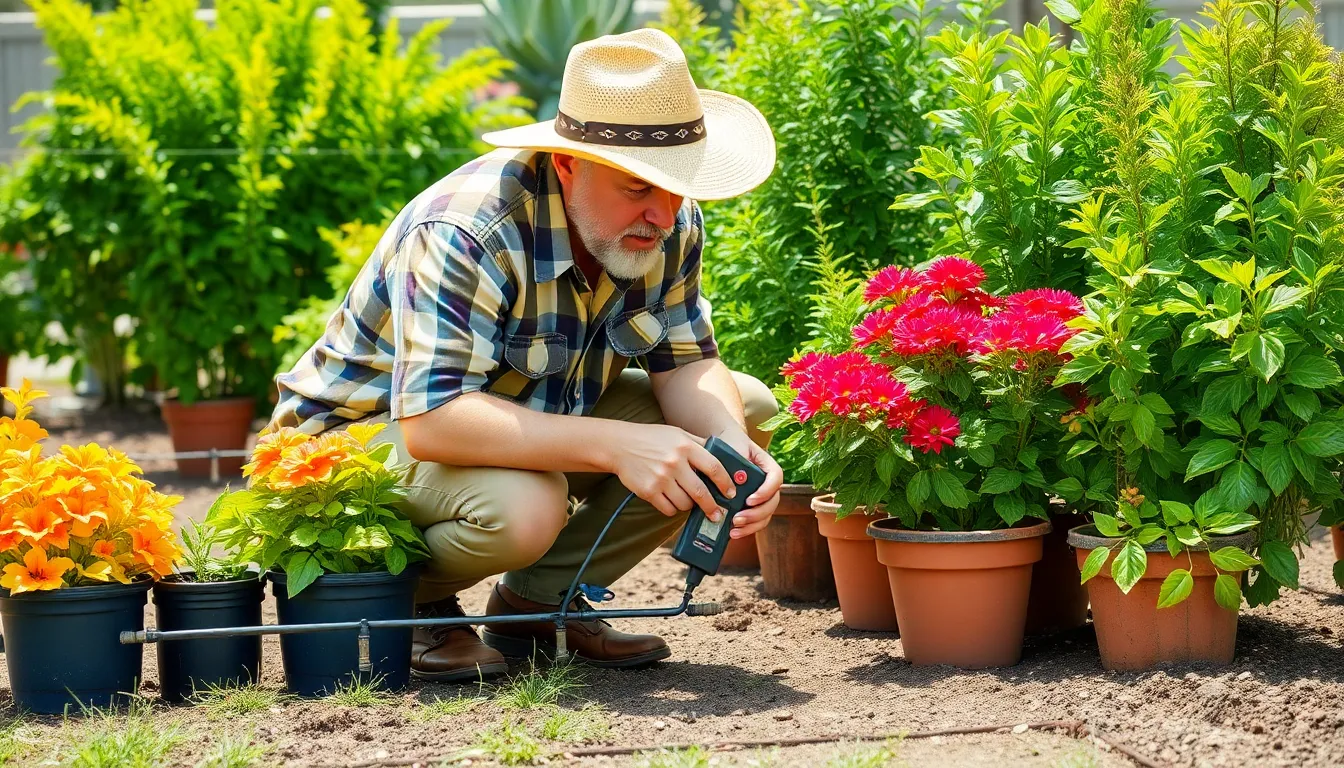
Proper watering forms the foundation of successful container gardening, requiring us to balance moisture needs with seasonal variations. Container plants depend entirely on us for their water supply, making consistent monitoring and adjustment essential for their health.
Install Efficient Irrigation Systems
Drip irrigation systems offer the most efficient way to water our container gardens while minimizing waste and disease risk. These systems deliver water directly to the soil surface, preventing the fungal issues that often arise from overhead watering methods.
Soaker hoses provide another excellent option for uniform water distribution across multiple containers. We can easily install these flexible systems around our container arrangements, ensuring each plant receives adequate moisture without manual watering.
Automatic timers enhance our irrigation efficiency by maintaining consistent watering schedules even when we’re away. These devices help us avoid the common mistake of irregular watering that stresses container plants and reduces their overall health.
Monitor Soil Moisture Levels Regularly
Finger testing gives us immediate feedback about soil moisture conditions in our containers. We simply insert our finger 1-2 inches into the soil to check for dampness before deciding whether to water.
Moisture meters provide more precise readings for gardeners who prefer technical accuracy over manual testing. These inexpensive tools help us maintain optimal moisture levels across different container sizes and plant varieties.
Daily checks become necessary during hot summer months when container soil dries out rapidly. We should examine our containers each morning to identify plants that need immediate attention before heat stress occurs.
Adjust Watering Frequency by Season
Summer watering demands increase significantly as heat and wind accelerate evaporation from container soil. Plants in full sun locations may require daily watering, while those in partial shade need water every 2-3 days during peak heat.
Spring and fall seasons allow us to reduce watering frequency as cooler temperatures slow evaporation rates. We typically water every 5-7 days during these moderate seasons, adjusting based on rainfall and individual plant needs.
Winter watering becomes minimal for most container plants, especially those that enter dormancy. We should water only when soil becomes completely dry, as overwatering during cold months can damage roots and promote disease.
Mulching our container surfaces helps retain moisture and reduces seasonal watering variations. A 2-inch layer of organic mulch can cut our watering frequency by 30-40% while maintaining consistent soil temperature.
Feed Your Potted Plants with Appropriate Fertilization
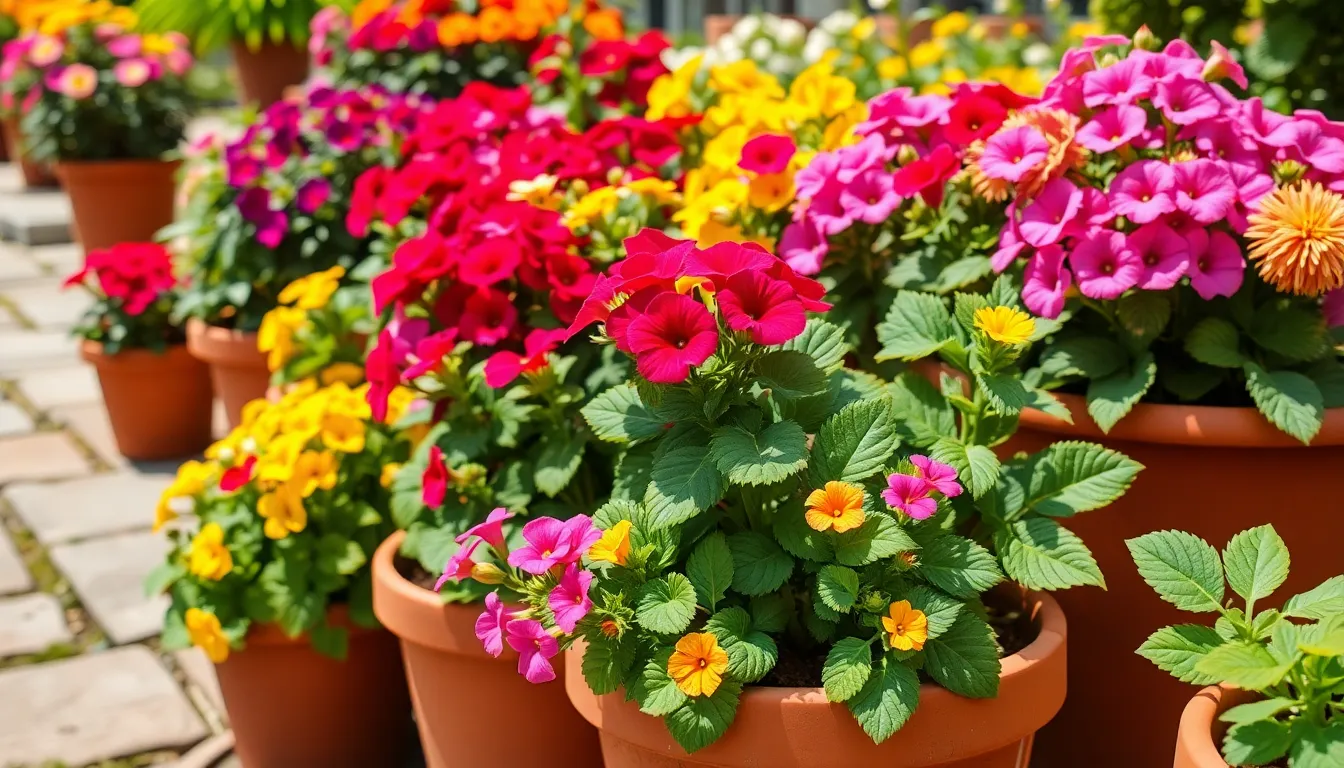
Outdoor potted plants require a steady supply of nutrients since their container soil becomes depleted faster than garden beds. Fertilization compensates for limited soil volume and frequent watering that leaches essential nutrients.
Choose Container-Exact Fertilizers
Use fertilizers formulated specifically for container plants to provide nutrients in a controlled manner. Slow release granules suited for potted plants reduce the risk of overfeeding or nutrient shock compared to standard garden fertilizers.
Look for balanced formulations containing nitrogen, phosphorus, and potassium that support comprehensive plant health. These three essential nutrients promote leaf growth, flowering, and root development in outdoor potted ornamentals such as petunias, geraniums, pansies, and impatiens.
Granular slow release fertilizers offer consistent nutrient delivery over several months. Container exact liquid fertilizers provide immediate nutrition when plants show signs of nutrient deficiency.
Follow Proper Application Timing and Rates
Apply fertilizer at key growth stages to maximize plant health and flowering potential. Early spring application when plants begin new growth ensures nutrients are available during active development periods.
Avoid fertilizing during dormancy periods to prevent waste and potential root damage. Winter applications can cause salt buildup in containers without providing benefits to inactive plants.
Follow label instructions carefully for application rates to avoid excessive fertilization that can harm roots. Overfeeding container plants often causes more damage than underfeeding due to concentrated soil conditions.
Remove the top 2 inches of old compost from established containers early in spring for optimal nutrient renewal. Incorporate slow release fertilizer granules before replacing soil and adding mulch to refresh nutrients for the growing season.
Supplement slow release feeding with liquid applications every 2 to 4 weeks during active growing seasons. Container plants with high nutrient demands benefit from this dual feeding approach that maintains consistent nutrition levels.
Protect Your Outdoor Potted Plants from Weather Extremes
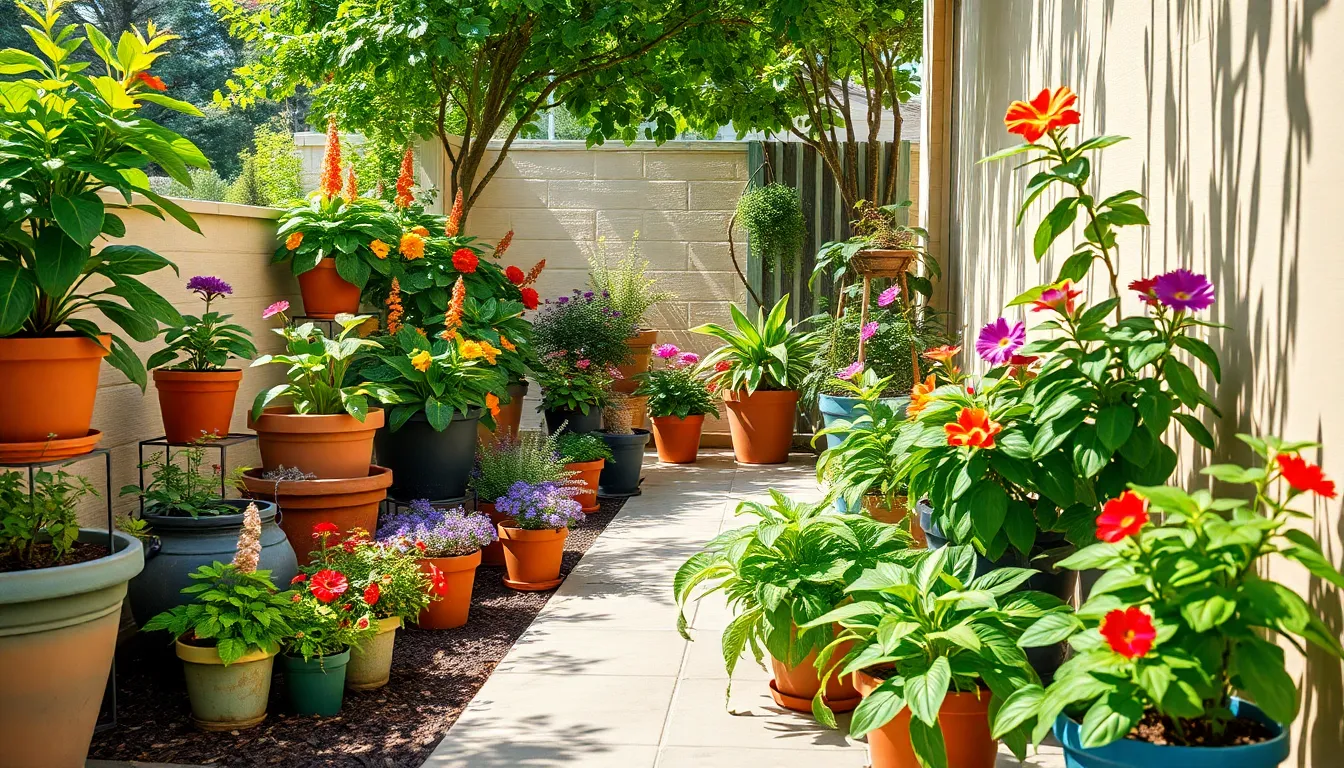
Weather extremes can devastate our carefully curated outdoor container gardens if we don’t take proper protective measures. Effective protection strategies ensure our potted plants survive and thrive through seasonal challenges.
Prepare for Winter Temperature Drops
Moving containers to sheltered locations becomes our first line of defense against freezing temperatures. We should position our pots near walls or under covered areas to minimize exposure to harsh winter conditions.
Insulating our containers prevents root damage from freezing soil. Bubble wrap works excellently as an insulation material, while placing pots on raised surfaces like plant stands keeps them off frozen ground.
Choosing larger containers provides better insulation for root systems during cold snaps. Bigger pots retain heat more effectively than smaller ones, creating stable root environments that resist temperature swings.
Shield Plants from Harsh Summer Heat
Frequent watering becomes essential during hot weather since containers dry out much faster than garden beds. We need to water deeply and thoroughly when the soil surface feels dry, often requiring daily watering during peak summer heat.
Timing our watering sessions properly prevents foliar diseases. Morning watering allows plants to dry before evening, reducing prolonged moisture on leaves that can lead to fungal problems.
Applying mulch to soil surfaces helps retain moisture and cool root systems. Organic mulches like bark chips or straw create an insulating layer that reduces water evaporation and temperature fluctuations.
Ensuring proper drainage prevents waterlogged soil even with frequent watering. Water should drain freely from container bottoms, allowing deep root penetration while avoiding root rot.
Secure Containers Against Strong Winds
Positioning pots in wind sheltered areas protects both plants and containers from damage. Patios, courtyards, and areas near buildings provide natural windbreaks that reduce exposure to strong gusts.
Securing containers with weights or ties prevents toppling during storms. Heavy bases or anchoring systems keep tall containers stable even when wind speeds increase.
Choosing wind resistant plants reduces stress on our container gardens. Sturdy varieties with flexible stems and smaller leaves handle windy conditions better than delicate species with large foliage.
Regular pruning maintains plant shape and reduces wind resistance. Deadheading spent flowers and trimming overgrown branches prevents containers from becoming top heavy and susceptible to wind damage.
Incorporate Seasonal Changes in Your Potted Plant Displays
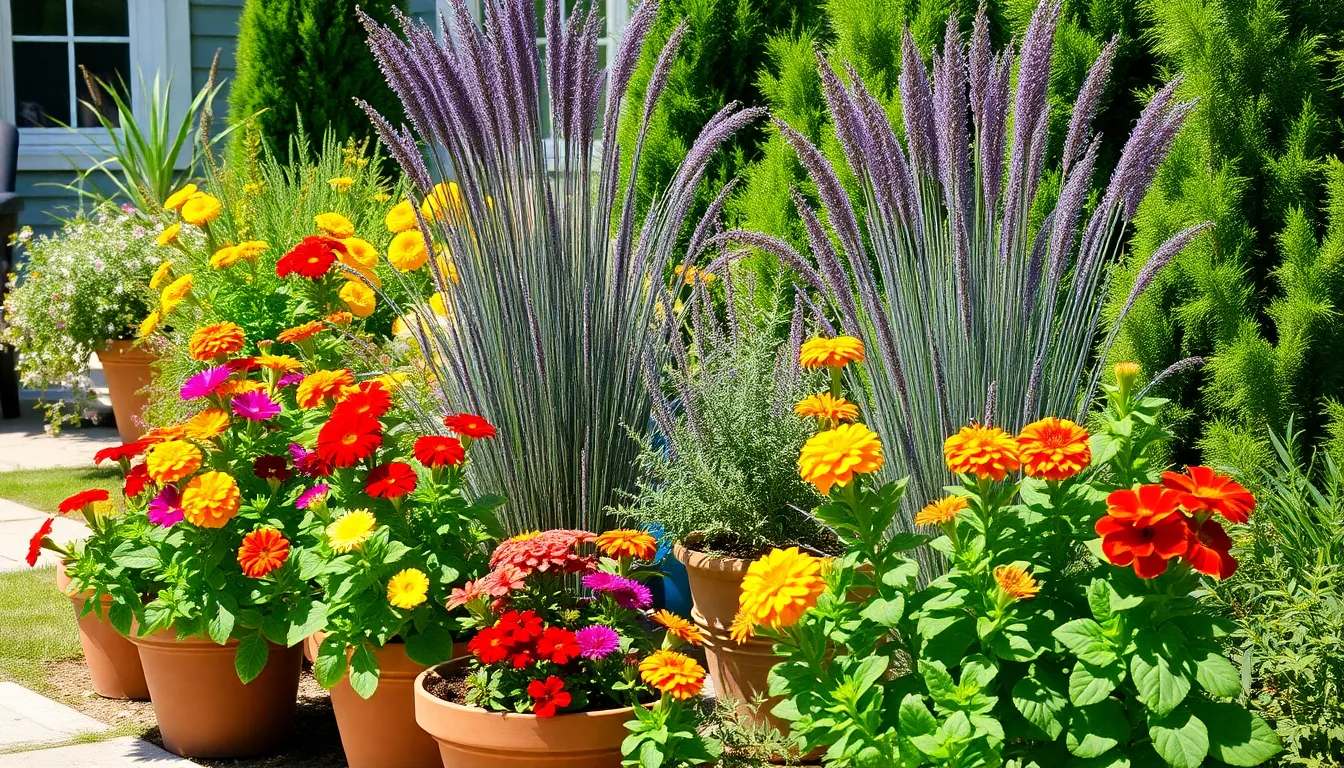
We can transform our outdoor container gardens into ever-changing displays that evolve throughout the year by embracing seasonal transitions. Strategic seasonal planning keeps our potted landscapes visually captivating while ensuring plant health across changing weather conditions.
Plan Spring and Summer Arrangements
Spring and summer arrangements thrive on vibrant colors and lush growth during warmer months. We recommend selecting flowering annuals like petunias, marigolds, and geraniums that encourage abundant blooms in full sun conditions. Popular choices include herbs such as rosemary and garden sage, which offer low maintenance benefits while providing aromatic foliage and culinary value.
Adding texture and height becomes effortless with plants like purple fountain grass, which creates dramatic vertical interest in our containers. Regular watering schedules support vigorous growth during these active seasons, while occasional fertilizing maintains healthy development. Combining these elements creates containers that serve as focal points throughout the warmest months of the year.
Design Fall and Winter Container Gardens
Fall and winter containers require plants with strong architectural structure and evergreen foliage to maintain visual interest. We focus on selecting species like yucca, which provides year round form, and bergenia, which shines during fall before dying back in winter. Winter jasmine emerges as an excellent choice for cold weather displays, offering fragrant blooms during harsh months while requiring minimal pruning and watering.
Incorporating plants with varied textures, colorful berries, or interesting seed pods adds seasonal character to our winter arrangements. These elements create visual depth when traditional flowering plants become dormant. Evergreen selections ensure our containers remain attractive even during the most challenging weather conditions.
Execute Smooth Seasonal Transitions
Smooth seasonal transitions involve gradually introducing climate appropriate plants while phasing out species past their prime growing periods. We achieve seamless changes by overlapping plantings, ensuring our containers always maintain some active growth and visual appeal. Adjusting watering schedules becomes crucial as temperatures drop, with reduced fertilizing requirements during cooler months.
Moving tender plants indoors or to sheltered locations protects them during harsh winter weather, while versatile container designs accommodate these seasonal shifts. Consistent monitoring allows us to respond quickly to changing plant needs throughout transitions. This systematic approach maintains visual impact while supporting plant health across all seasons.
Conclusion
Container gardening offers us an incredible opportunity to transform any outdoor space into a stunning industry filled with vibrant plants and creative design elements. We’ve explored everything from selecting the perfect containers and plants to mastering watering schedules and seasonal transitions that keep our displays looking fresh year-round.
The beauty of potted plant landscapes lies in their flexibility – we can experiment with different arrangements create focal points and adapt our gardens to changing seasons without the permanence of traditional planting. Whether we’re working with a small balcony or expansive patio the principles remain the same: thoughtful planning proper care and creative vision.
By implementing these strategies we’re not just growing plants – we’re crafting outdoor experiences that bring joy beauty and a personal touch to our living spaces. Our container gardens become ever-changing extensions of our homes that evolve and flourish with each passing season.
Frequently Asked Questions
What are the main benefits of container gardening for outdoor spaces?
Container gardening offers flexibility and creativity without requiring extensive gardening skills or permanent plantings. You can easily redesign your outdoor spaces like patios and balconies, experiment with color, texture, and height, and transform any area into a lush retreat. It’s perfect for personalizing outdoor spaces with minimal commitment.
How do I choose the right containers for outdoor potted plants?
Select containers with proper drainage holes to prevent root rot and ensure healthy growth. Choose weather-resistant materials that can withstand seasonal changes. Evaluate container size based on your specific plant types and plan for future growth by selecting appropriately sized containers that balance visual appeal with stability.
What types of plants work best in outdoor containers?
Choose plants that can handle confined root space and varying outdoor conditions. Select climate-appropriate species like garden sage for sunny locations or winter jasmine for adaptable conditions. Group plants with similar water requirements together and consider seasonal interest by mixing perennials with annuals for year-round appeal.
How should I arrange containers for maximum visual impact?
Use strategic container placement to create rhythm and repetition, and vary container heights to establish layered dimensions. Apply color theory with contrasting and analogous colors for aesthetic appeal. Follow the thriller, filler, spiller principle to create focal points and memorable visual experiences in your design.
Where should I place my potted plants for optimal growing conditions?
Consider three essential factors: sunlight requirements, wind exposure, and accessibility for maintenance. Match each plant’s light needs (full sun, partial shade, or full shade) to the location. Protect delicate plants from strong winds with barriers or wind-resistant varieties, and position containers near water sources for easy care.
How often should I water my container plants?
Monitor soil moisture regularly using finger testing or moisture meters. Adjust watering frequency seasonally – increase during summer heat and reduce in spring and fall. Use efficient irrigation systems like drip irrigation or soaker hoses with automatic timers for consistent schedules. Minimize winter watering for dormant plants.
What fertilization do outdoor potted plants need?
Container plants need more frequent fertilization than garden beds since nutrients deplete faster. Use fertilizers specifically formulated for containers, like slow-release granules, for balanced nutrition. Apply fertilizer during key growth stages, avoid feeding during dormancy, and supplement with liquid fertilizers during the growing season for optimal health.
How can I protect my potted plants from weather extremes?
Move containers to sheltered locations during winter to prevent freezing damage and insulate pots to protect roots. In summer, ensure frequent watering, proper drainage, and use mulch to retain moisture. Secure containers against strong winds, choose wind-resistant plants, and prune regularly to reduce wind resistance.
How do I create seasonal displays with container plants?
Plan strategically for each season to maintain visual interest year-round. Use vibrant flowering annuals and herbs for spring and summer displays. For fall and winter, select plants with strong architectural structures and evergreen foliage like yucca and bergenia. Execute smooth transitions by gradually introducing climate-appropriate plants.
What’s the thriller, filler, spiller principle in container design?
This design principle creates visually appealing container arrangements using three plant types: thriller (tall, dramatic centerpiece plant), filler (medium-height plants that fill space around the thriller), and spiller (trailing plants that cascade over container edges). This combination creates balanced, professional-looking displays with multiple levels of interest.

